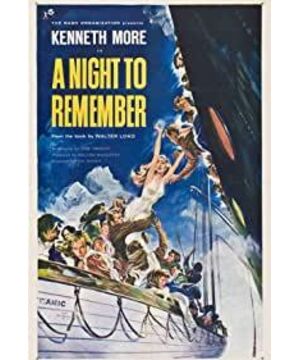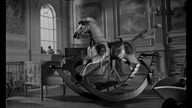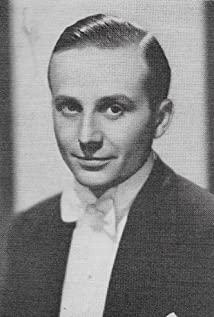Funeral of the times
A Night to Remember
Filmed in 1958, "The Shipwreck in the Ice Sea" was the most important film on this subject before James Cameron. Its brilliance is not only the creation of countless Gaoming bridges similar to the continuous performance of the band, which is paid tribute by Cameron, but more importantly, the film carries a generation's nostalgic criticism of that passing era. A cruise ship that divides passengers into three classes. The distance between life and death is only £12 for a bed and £875 for an suite.
A child's dream
The story of "The Shipwreck in the Ice Sea" starts with the curiosity of a child in 1911. That year, producer William McQuetti was only six years old and lived in Belfast, England. One day, William Jr. saw 20 horses pulling a huge anchor to the Harland and Woolf shipyards, where a huge ship was being gestated. Every day, he watched the huge ship take shape and asked his father how to get this ship into the sea. Father said that they put the boat on the pulley, and when it was launched, they smeared soap and grease on the pulley, and gently pushed on the bottom of the boat, and the boat slipped into the water. This ship was undoubtedly the largest ship in the world at the time-the Titanic.
In May 1912, William Jr. was extremely proud for a whole month, not only because he was about to celebrate his seventh birthday, but also because he was able to witness with his own eyes the ship leaving its birthplace and launching for the first time with countless people. On the 31st, as my father said, people just gave it a light push. After a while, the ship began to move forward slowly, and because the Titanic was too large, William Jr. seemed to feel that he was actually moving. In the dark, he felt an invisible connection with Da Chuan. Titanic, who is about to travel all over the world, carries William's dream of escaping Belfast and breaking into the world, and he has a small harbor in front of him, and he is connected to the seven continents and four oceans. With this step, the world is right in front of him...
A brilliant outcast
Although the Titanic did not successfully complete its maiden voyage, William left Belfast in 1924 to work for Standard Chartered Bank. Relying on the convenience of work, traveling around the world, finally came to Shanghai. In China, he received news that his mother's cancer was critically ill and had to return to his hometown. After the death of his mother, William took to the battlefield of World War I and became a propaganda soldier, making documentaries. It was during this period that the idea of shooting a Titanic movie came up. After the war, William took the path of a producer. During the time when his daughter was born, he read Walter Rod's documentary novel "An Unforgettable Night" and exclaimed that this was exactly what he was looking for. The next day, he took the novel to Rank Films and tried to persuade the chairman, John Davis, to adapt it into a movie. But Davis is extremely indifferent. In his opinion, a big investment black-and-white shipwreck film without a star is simply too difficult to make money. But William’s answer is categorically “This is not an ordinary shipwreck, it is a sign of the end of the era.”
In his opinion, the Titanic is not an ordinary cruise ship. In that era, it was a symbol of identity and status. The first class was extremely luxurious. The cabin was closed, and there was no chance to board the lifeboat. "Let the ladies and children go first" has also been misunderstood as "only the ladies and children are allowed to go." It wasted nearly 700 seats on the lifeboat. At the memorial service for the Titanic victims in Belfast, the names of the victims were also sorted by status. No matter how you look at it, the Titanic is a product of an age of arrogance.
William's remarks moved Davis, and he immediately called the novel author Rod...
Perseverance of a writer
Water Rod, who lives in New York, is an ordinary clerk in an advertising company. But for some reason, he was always inexplicably attracted by the story of the Titanic. From the age of nine, he was always stuck with this huge ship like a child with a cold. Others go to the library to read French classics, but Rod is always looking for old newspapers about the Titanic, and hearing materials, and study hard.
After completing a book about the American Civil War in his spare time, Rod won the appreciation of editor Howard Katie and made suggestions for his next book. "Since you always talk about the Titanic, Why not write a novel about it?" The words awakened Rhode. In fact, Rhode’s preparations were sufficient, and he quickly laid out the outline, finished the draft, and found a lot of precious materials. But all this is far from enough, he still needs to look for the survivors of that year.
At the time, finding the survivors of the Titanic was a difficult task, because there was no such organization as the Survivor’s Club or the Association. In fact, after 1913, reports and follow-ups on the Titanic had stalled. . Rod carefully selected the most likely cities for survivors to live in, including Chicago, New York, and Belfast. Write a letter to the editor of a local newspaper, hoping to be published in their readers letter column. Rod wrote hundreds of letters and attached his address, hoping that the survivors could contact him. Unexpectedly, replies came one after another, more and more, and finally 64 replies were received. It only took the stamp money to find so many survivors, which made Rhode extremely happy.
As the novel went smoothly, the title of the book became a distressing question for Rod. One day, Rod was strolling around 38th Street and Parker Street in New York. Looking at the bright night sky, he suddenly thought of "Unforgettable Night" as the title of the book. The editors were shocked by the absence of "Titanic" in the title of the book, but they were smart enough to drew a lifebuoy on the cover of the final published novel and wrote "RMS Titanic".
After the novel was released, it was also extremely successful, with more than sixty editions released worldwide. Rod quit his job in an advertising company and began to promote the novel full-time. One day, he received a call, "There is a famous British producer who wants to make your novel into a movie. Would you like it?" Rhode's answer was also very simple, "Of course I would, if I can, I would like to participate. Shoot!"
Restoration of a movie
In 1957, the filming of "Ice Sea Sunken Ship" officially started, and Rod was also invited to the set, and he also brought many survivors of the shipwreck as a set consultant. These include Joseph Posol, the fourth mate of the Titanic, who was patrolling on the deck when the ship hit an iceberg; the widow of the second mate played by Kenneth Moore in the film; and a personal relationship with Rhodes. Deep first-class passenger Edith Russell.
Edith is the prototype of the passenger looking for the musical pig in the film. Back then, as a guest of honor on the Titanic, she reserved a room for clothes. And that musical pig was a relic left to Edith by his father before his death. At that time, she had boarded the lifeboat, but because she had forgotten the pig, she turned back and looked for it. When she came back, the lifeboat was already descending, and she did not dare to jump down. The sailor on the side snatched the tightly packed musical pig in her arms and threw it on the lifeboat "Follow your child, jump!" (He treated the pig as a baby) she jumped down. After Edith passed away, he left the pig to Rod in his will, but the music pig never played music again. Countless stories like this have been reproduced in the movie.
In addition to the story, rebuilding the Titanic has also become the top priority of the crew. A large number of set productions cost a total of 4,000 tons of steel. Initially, the crew contacted the British cruise ship Sean Saverin as the live shooting location. But the cruise liner temporarily withdrew from the plan because it was unlucky to take a story about a shipwreck. Disappointed, William flew to Clyde and found the Australian cruise ship Asturias that was about to be disintegrated at the WD Ward Shipyard. Although the port side has been removed, the starboard side is still intact. The boat can float on the water. William was ecstatic and rented a boat for £100 for the crew to shoot for ten days. The shipwreck scene at the climax was filmed in a pond, and the crew produced many miniatures for shooting distant scenes. The most advanced waterproof camera at the time was used to take the subjective shot of the bow of the ship entering the water.
Fortunately for William, the filming of the entire film was completed between November and January of the following year. The integrity of the winter is cold, and the actor's cold performance is true and credible. The studio is equipped with a high-temperature drying room where actors who have finished filming in the water can immediately dry them together with their clothes. While maintaining the body temperature, it also saves money on the second set of costumes. And Moore even put on a frogman suit in the costume to keep warm and at the same time prevent moisture. On the day of the filming, there was no wind in the world, but it was extremely cold. In Rod’s words, it was “just the same as that night”.
After the film was released, William participated in a month of American publicity. He brought more than 100 Titanic survivors to Times Square in New York for the premiere, which made the film a great influence and became the best-selling film of Rank Films, and successfully won the Golden Globe Award. Best English Foreign Film Award. Since then, more and more survivors of the Titanic have surfaced, and a survivor contact information has finally been established.
(Originally published in the Digital Entertainment DVD Guide)
View more about A Night to Remember reviews











